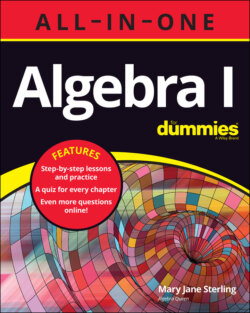Читать книгу Algebra I All-in-One For Dummies - Mary Jane Sterling, Mary Sterling Jane - Страница 27
Relating operations with symbols
ОглавлениеThe basics of algebra involve symbols. Algebra uses symbols for quantities, operations, relations, or grouping. The symbols are shorthand and are much more efficient than writing out the words or meanings. But you need to know what the symbols represent, and the following list shares some of that information. The operations are covered thoroughly in Chapter 6.
+ means add or find the sum or more than or increased by; the result of addition is the sum. It also is used to indicate a positive number.
– means subtract or minus or decreased by or less; the result is the difference. It’s also used to indicate a negative number.
× means multiply or times. The values being multiplied together are the multipliers or factors; the result is the product. Some other symbols meaning multiply can be grouping symbols: ( ), [ ], { }, ·, *. In algebra, the × symbol is used infrequently because it can be confused with the variable x. The symbol is popular because it’s easy to write. The grouping symbols are used when you need to contain many terms or a messy expression. By themselves, the grouping symbols don’t mean to multiply, but if you put a value in front of or behind a grouping symbol, it means to multiply.
÷ means divide. The number that’s going into the dividend is the divisor. The result is the quotient. Other signs that indicate division are the fraction line and slash, /.
means to take the square root of something — to find the number, which, multiplied by itself, gives you the number under the sign. (See Chapter 6 for more on square roots.)
means to find the absolute value of a number, which is the number itself or its distance from 0 on the number line. (For more on absolute value, turn to Chapter 2.)
π is the Greek letter pi that refers to the irrational number: 3.14159. It represents the relationship between the diameter and circumference of a circle.
is the greatest integer operation. It tells you to evaluate what’s in the brackets and replace it with the biggest integer that is not larger than what’s in them.
Q. Use mathematical symbols to write the expression: “The product of 6 and a is divided by the difference between the square of a and 1 and added to the square root of the difference between pi and r cubed.”
A. . You don’t need a dot between the 6 and the a. Writing the two factors together indicates a product. Putting the binomial in the denominator indicates that you’re dividing the 6a by that expression. The exponent of 3 indicates r is being cubed. The two terms in the difference both appear under the radical.
Q. Use mathematical symbols to write the expression: “The absolute value of the sum of x and 8 times the greatest integer value of the quotient of x and 3.”
A. . The dot between the absolute value and greatest integer operations isn’t really necessary, but it helps define better what you’re expressing.
13 Use mathematical symbols to write the expression: “Four times z plus the square root of 11.”
14 Use mathematical symbols to write the expression: “The difference between x and two is divided by pi.”
15 Use mathematical symbols to write the expression: “The product of six and the absolute value of the sum of eight and y is divided by the square root of the difference between 9 and x.”
